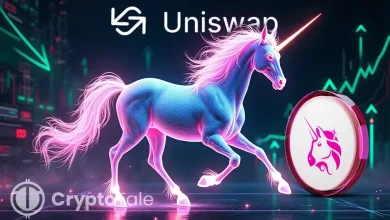Circle Unveils ARC Blockchain, Reports 53% Revenue Increase

- Circle’s Arc blockchain aims to lower reliance on external networks for USDC.
- Q2 results show 90% USDC growth, boosting Circle’s market share in stablecoins.
- Arc offers sub-second settlement, FX engine, and privacy for stablecoin finance.
Circle has announced plans to launch a stablecoin-focused, EVM-compatible Layer 1 blockchain called Arc. The network will run a public testnet later this year, marking a significant expansion from its current role as a stablecoin issuer. Arc is designed for enterprise-grade stablecoin payments, foreign exchange, and capital markets use cases, with USDC functioning as the native gas token. The network will feature sub-second settlement, a stablecoin FX engine, opt-in privacy, and full integration with Circle’s platform.
Circle stated that Arc will remain interoperable with its partner blockchains while aiming to consolidate stablecoin infrastructure under its control. This move positions Circle to reduce reliance on third-party networks for transaction settlement. It also follows similar initiatives by other industry players, including Tether, which supports two stablecoin-focused blockchain projects, Stable and Plasma. The announcement comes amid increasing competition in blockchain infrastructure from both crypto-native firms and traditional finance institutions.
Financial Performance Ties to Strategic Positioning
The Q2 2025 earnings of Circle were remarkable since they symbolized the massive adoption of USDC and other forms of platform growth. The supply of USDC in circulation rose 90% year-over-year to $61.3 billion, with an additional increase to $65.2 billion by August 10. The overall revenue and reserve income increased by 53% annually to $658 million, followed by the growth of other revenue at 252% due to subscription, services, and transaction activity. Nevertheless, the company registered a net loss of 482 million dollars, especially because of 591 million non-cash costs related to the IPO.
These charges included $424 million in stock-based compensation and $167 million related to the fair value increase of convertible debt. Adjusted EBITDA grew 52% to $126 million, highlighting operational strength apart from IPO expenses. Circle’s IPO in June raised $1.05 billion, debuting at $69 per share and briefly reaching $292.8 before settling at $161.2 as of Monday. The company’s market position remains reinforced by its role as the second-largest stablecoin issuer, with $65 billion in supply.
Competitive Landscape in Blockchain Infrastructure
Arcs’ launch is part of the larger direction towards building blockchain infrastructure by large fintech and crypto companies. Stripe has also been said to be developing a blockchain network in collaboration with Paradigm called Tempo. A tokenization-centered Layer 2 blockchain was announced by Robinhood at the end of June, whereas Shopify has begun accepting payments in USDC provided via Coinbase Base.
Arc is an operational hedge and a growth strategy that Circle is pursuing with its launch. The ownership of a proprietary Layer 1 chain will give the company the ability to streamline settlement costs, make native usage of the USDC, and create deeper integration with financial applications. The strategy would make a defendable moat through the coordination of stablecoin releases with direct network governance.
Related: Circle’s Developer Service Circle Gateway To Boost USDC Liquidity Across Chains
Regulatory Context and Market Implications
Circle emphasized the regulatory clarity provided by the recent GENIUS Act, which President Trump signed last month. The bill introduces a federal framework that establishes payment stablecoins, which sets many of the compliance practices that Circle already follows. Such a legal framework can add power to the Arc in its bid to attract regulated financial institutions in search of stablecoin-based settlement infrastructure. In the case of the stablecoin, regulatory certainty is necessary to create a competitive edge in the positioning of similar products.
Stronger financial services integration of stablecoins may also be sped up with the introduction of Arc, lowering friction in global payments and settlement of assets. The network has the potential to decrease its reliance on Ethereum and other blockchains to transact USDC, if it is successful. However, the competitive response from other issuers and infrastructure providers will influence adoption.




